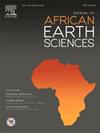埃森地层(阿尔及利亚东北部泰贝萨山脉)科尼亚期(上白垩世)无脊椎动物的类群关系
IF 2.2
4区 地球科学
Q2 GEOSCIENCES, MULTIDISCIPLINARY
引用次数: 0
摘要
阿尔及利亚北部泰贝萨山脉的科尼阿克纪地层主要为泥灰岩层,很少有人对其进行研究。本研究是首次在 Djebel Essen(泰贝萨以西)进行的古环境研究。本研究鉴定的大型化石类群包括 15 个双壳类物种、3 个腹足类物种和 1 个头足类物种,以及 4 个不规则的回声类物种。对这些大型化石的定量分析表明,科尼阿克文明出现了三种底栖大型动物群落,包括1)Agelasina plenodonta;2)Cucullaea;3)Oscillopha-Plicatula。Agelasina plenodonta 和 Cucullaea 协会都是以小型动物为主。然而,Cucullaea 协会只包含悬浮取食者,完全不包含沉积取食者,这表明该协会处于低营养状态,可能导致其多样性水平最低。相比之下,附生类群在 Oscillopha-Plicatula 协会中占主导地位。这三个类群都是低营养群。在研究地区和其他北非国家,科尼阿西亚类群的多样性较低,这可能是由于海水退缩和较浅栖息地面积缩小的缘故。也许,这些群落生活在有限的边缘海洋环境中。没有任何潜在的指标表明发生了中上康尼阿克纪缺氧事件(OAE-3),这与附近地段的情况一致,证实了这一事件的范围有限。许多具有区域或世界性亲缘关系的类群的出现表明,它们与哲罗纪大洋存在着偶发性联系。本文章由计算机程序翻译,如有差异,请以英文原文为准。
Paucispecific invertebrate associations in the Coniacian (Upper Cretaceous) Essen Formation (Tébessa Mountains, northeast Algeria)
The Coniacian strata of the Tébessa Mountains in northern Algeria are predominantly marly facies that have received few studies. The present study is the first one to be carried out at Djebel Essen (west of Tébessa) to reveal the paleoenvironmental setting. The macrofossil taxa identified herein include fifteen bivalve species, three gastropods, and one cephalopod species, in addition to four irregular echinoid species. Quantitative analysis of these macrofossils indicates the occurrence of three benthic Coniacian macrofaunal associations, which include: 1) Agelasina plenodonta, 2) Cucullaea, and 3) Oscillopha-Plicatula. Both Agelasina plenodonta and Cucullaea associations are dominated by infauna. However, Cucullaea Association contains only suspension-feeders, where deposit-feeders are completely absent, suggesting oligotrophic conditions, that might have resulted in the lowest diversity level. In contrast, epifaunal taxa dominated the Oscillopha-Plicatula association. All the three associations are paucispecific. This low diversity of the Coniacian associations at study area and in other North African countries, can be attributed to the retreat of the sea and the shrinking of shallower habitats’ area. Probably, these associations lived within restricted marginal marine environments. The absence of any potential indicator of the middle-upper Coniacian anoxic event (OAE-3) agrees with the case in nearby sections and confirms a restricted extent of this event. The occurrence of many taxa of either regional or cosmopolitan affinity suggests episodic connection with the Tethyan Ocean.
求助全文
通过发布文献求助,成功后即可免费获取论文全文。
去求助
来源期刊

Journal of African Earth Sciences
地学-地球科学综合
CiteScore
4.70
自引率
4.30%
发文量
240
审稿时长
12 months
期刊介绍:
The Journal of African Earth Sciences sees itself as the prime geological journal for all aspects of the Earth Sciences about the African plate. Papers dealing with peripheral areas are welcome if they demonstrate a tight link with Africa.
The Journal publishes high quality, peer-reviewed scientific papers. It is devoted primarily to research papers but short communications relating to new developments of broad interest, reviews and book reviews will also be considered. Papers must have international appeal and should present work of more regional than local significance and dealing with well identified and justified scientific questions. Specialised technical papers, analytical or exploration reports must be avoided. Papers on applied geology should preferably be linked to such core disciplines and must be addressed to a more general geoscientific audience.
 求助内容:
求助内容: 应助结果提醒方式:
应助结果提醒方式:


